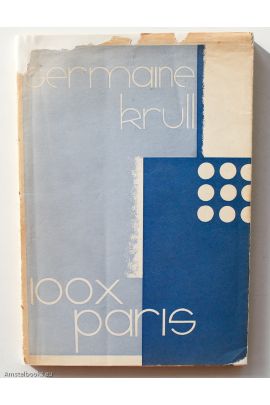| Author | Germaine Krull |
|---|---|
| Pages | 100 |
| Signed | No |
| Publisher | Verlag Der Reihe |
| Publishing date | 1929 |
| Publishing place | Berlin |
| Language | English, French, German |
| Edition | First edition |
| Binding | Softcover with dustjacket |
| Book condition | Collectible; Very Good |
| Condition description | Dustjacket frayed and missing some fragments, interior clean, some toning; else fine; nice copy including the scarce dustjacket. |
| Cover condition | Fair |
| Dimensions (cm hxb) | 25x17 |
"Germaine Krull (1897-1985) led an extraordinary life that spanned nine decades and four continents. She witnessed many of the high points of Modernism and recorded some of the major upheavals of the twentieth century. Her photographs include avant-garde montages, ironic studies of female nudes, press propaganda shots, magazine picture stories, and some of the most successful commercial and fashion images of her day. Her political commitments led her from Communist allegiance to incarceration in Russia as a counter-revolutionary, to support of the Free French cause against Hitler, to ownership of the Oriental Hotel in Bangkok, to a final reclusive existence among Tibetan monks in India.Any understanding of Germaine Krull's photographic production must take into account her fiercely individualistic political and professional beliefs. Her work and life were inextricably intertwined, and photography allowed her to respond to the cultures she moved through. Krull was one of the most influential modern photographers of the interwar years, and almost single-handedly introduced German New Vision photography to France. Yet she refused to acknowledge a distinction between avant-garde and commercial practice. Her broad photographic activities were not exceptions; rather, they constituted a normal pattern for photographers of her time.Krull's work falls into three sections that not only mirror the broad geographical and chronological divisions, but also incorporate the large issues with which she grappled as she constantly renegotiated her position regarding Modernism. Her career divides logically into three sections -- Germany and Russia from 1915 to 1925, Holland and France from 1925 to 1940, and Africa and Asia from 1940 until the end of her life. These divisions are philosophical divisions as well. Krull reacted to and used her photographs to shape three of the most exciting and troubling developments of her era -- the growing equality of women, the expansion of industrialization, and the decline of colonialism. In her early work, she commented on and eventually transformed representations of the interwar New Woman. As a young woman in Munich, she adopted the prevailing style of Pictorialism. Then, in Berlin, she adopted the Freïkorperkultur of carefree Weimar society, but her nudes mocked as well as frolicked within the frames of the photographs."--SF MoMA
Archive
100 x Paris
€0.00
Die Reihe der Hundert / La Serie des Cents / The Hundred Series).softcover including dustjacket; 100 photogr plates, famous photobook of Paris; printed in photogravure in sepia;
Out of stock
